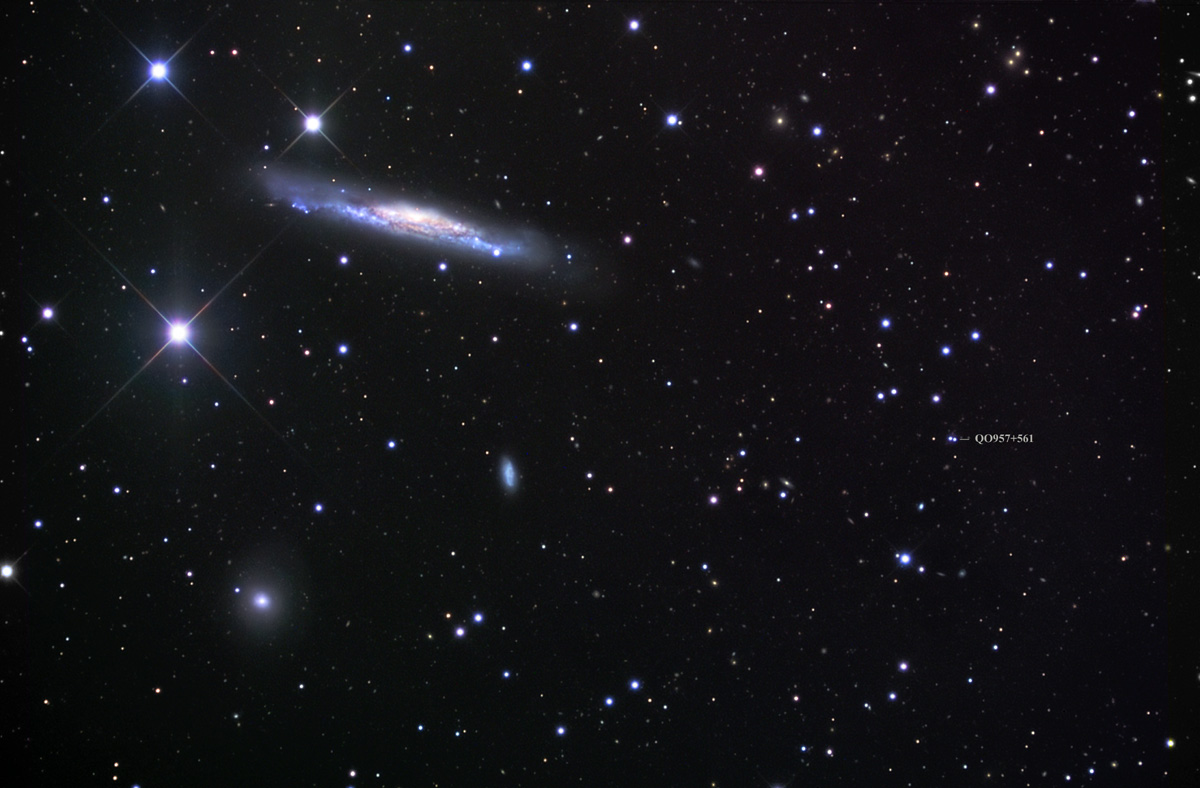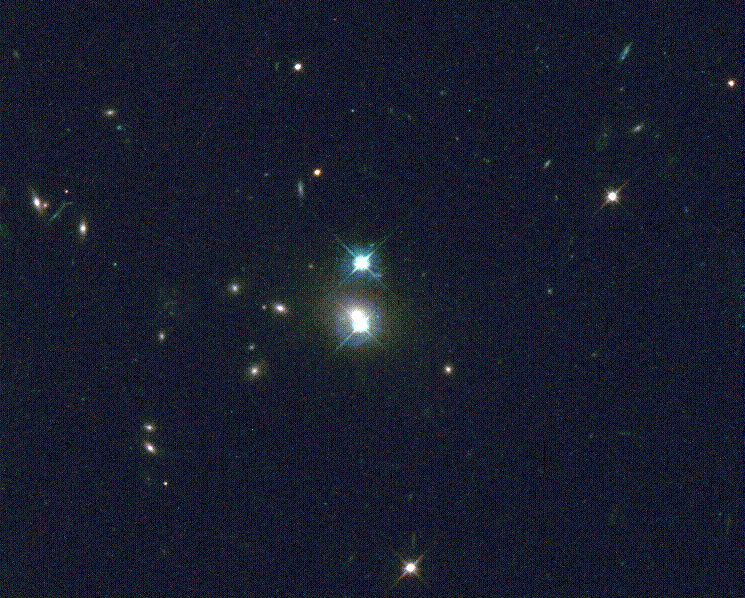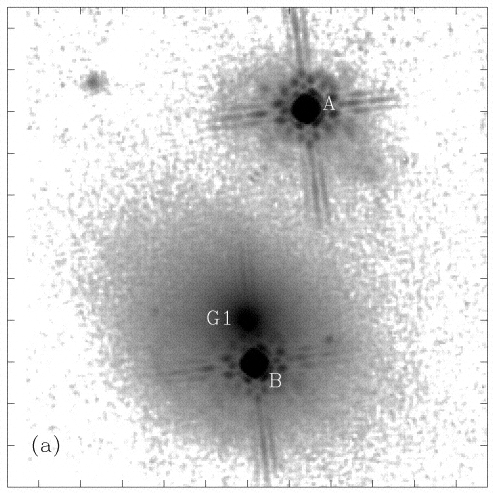
NGC 3079 is a worthy galaxy in its own right but the highlight of the accompanying field is the unassuming presence of the first gravitationally lensed quasar ever discovered, Q0957+561 (Walsh, Carswell, and Weymann, 1979). At quick glance the paired stellar objects appear to blend imperceptibly into the foreground starfield. The true nature of the pair as a lensed quasar first became apparent in 1979 when their remarkable redshifts (a measure of their recessional velocity which infers distance) were discovered implying two incredibly luminous objects at remote extragalactic distances. Further studies of the pair showed identical spectra and redshifts confirming that they indeed represent a single object whose double image is a mirage or optical illusion. The illusion is created by the curvature of space-time from a massive foreground object which splits the light of the quasar into two components.
The pair belongs to a rare group known as multiply-imaged or gravitationally lensed quasars. They are so rare that only a few dozen have been identified since the discovery of the first one Q0957+561, in 1979. They come in a variety of classes including double, triple, quadruple, symmetric and asymmetric. The origin of the multiple images is the presence of a massive foreground structure that exists in the line of sight to the quasar and is referred to as the lens. The lens is usually a massive galaxy or galaxy cluster whose immense gravity bends the fabric of space causing the light from the more distant quasar to bend around it. Because bending is not symmetric, observers will see multiple images or distorted images of the same object. If the lens is in direct alignment with the object and observer the mirage will be in the form of a ring (Einstein Ring). When alignment is not perfect two or more images form. The greater the mass of the lens the greater the separation of the images or larger the ring diameter becomes. The mass of the lens can therefore be determined by the appearance of the image. Lensed quasars have helped astronomers further define the distance scale of the universe in turn refining the elusive "Hubble Constant".
The Quasar Q0957+561 (redshift of 1.41) is an extremely remote object whose light was emitted some 9.1 billion years ago when the universe was a fraction of its present age. During the course of its long journey to earth, the light from the Quasar encountered a massive foreground object in the form of a giant elliptical galaxy at a redshift of 0.36 (its light is 3.9 billion light years old). As predicted by Einstein's general theory of relativity the massive galaxy and its cluster deforms the fabric of space-time, forcing light to bend around the galaxy rather than taking a straight path to the observer. The outcome is a double image of the quasar. The two components of the quasar (each about 17th magnitude) are known as A and B and are separated in the sky by only 6.1 arc seconds. The two components can vary by a tenth of a magnitude on a time scale as short as a week. The lensing galaxy (known as G1) is resolved in HST images and lies almost directly in line with the B component (1.0 arc seconds away). A virtual proof of the gravitational lens system awaited confirmation of a time delay which after much work was firmly established at 417 (+/-3) days. Any intrinsic fluctuation of the quasar shows up in both images but with a 417 day delay in component B.
Quasars are believed to represent the highly energetic cores of remote "active" galaxies that existed in the early universe. They are the most luminous objects known in the cosmos. Quasars can radiate up to 1000 times the light of a normal spiral galaxy such as the Milky Way. If the brightest quasar known were located 30 light years from earth it would shine as bright as the sun! Remarkably some quasars show variability in their light output over just a few days pointing to an incredibly compact source of their energy. Quasars radiate the energy of about a trillion times the energy of the sun from a region in their nucleus only slightly larger than our solar system. Evidence points to an accretion disk feeding matter into a supermassive black hole as the central engine powering the quasar. The energy released from accretion infall into a black hole is hugely efficient, converting mass to energy at 50% efficiency as opposed to only a few percent for nuclear fusion.
The quasar's central engine mechanism is believed identical to what powers its less energetic cousins existing in the present day universe, the Seyfert and radio galaxies. Similar to their present day cousins, quasars often exhibit powerful jets and lobes arising from their nucleus. Most quasars are found in the remote universe at distances of about 10 billion light years so they were much more common during an earlier epoch in our universe. Even the closest and brightest known quasars such as 3C273 in Virgo, are located some 2.5 billion light years away. It is likely that quasars represent an earlier stage in galactic evolution that no longer exists today. These super luminous and energetic galaxies may represent the "active" counterparts of the more evolved quiescent galaxies we see today populating our local universe.
Quasars were first described by the Dutch astronomer Marten Schmidt in 1963 as stellar objects having enormous redshifts. Their nature as distant energetic galaxies was not appreciated until the 1980's. The first quasars were detected from their strong radio emission and termed quasi-stellar radio sources. As more quasars were discovered most were found to be radio quiet (about 99%) so the term was contracted to quasi-stellar object (QSO). There are over 12,000 quasars known today. The furthest quasars have been discovered at redshifts exceeding 6 which translates to unthinkable distances. The most distant quasars emitted their light as much as 13 billion light years ago, at a time when the universe was only one tenth its present age. Remarkably it seems that quasars have the ability to turn on or off depending on the availability of mass in its accretion disk to feed the central black hole. Most quasars probably turn off after a few billion years or so when their central fuel supply becomes depleted however events such as galaxy interactions and mergers may turn them back on perhaps by providing more fuel for the central engine. There are competing theories regarding the nature of quasars and consensus is still not completely reached regarding their true nature.
The galaxy NGC 3079 is an intriguing galaxy in its own right. It has an "active galactic nucleus" similar to its super luminous ancient brethren, the quasars. It possesses a super massive black hole measuring some two million solar masses which powers its Seyfert type II nucleus. Unrelated to its AGN is a nuclear starburst region that has expanded a huge shell or superbubble across the galaxies minor axis stretching over 3000 light years. NGC 3079 also harbors one of the most luminous water masers known. Masers are often associated with AGN activity. (See NGC 4945 for more discussion regarding masers).

widefield image by Robert Gendler


Hubble Space Telescope images showing the lensed quasar (A & B) and the lensing galaxy G1